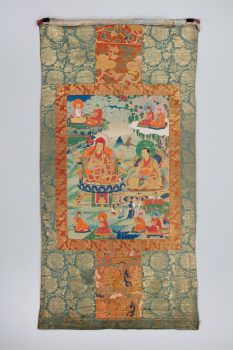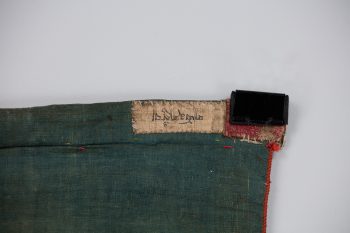Central Tibet
17th - 18th century




Central Tibet
17th - 18th century




This painting was part of a set and depicts Sakya Pandita (1182–1251), one of the forefathers of the Sakya tradition and throne-holders of Sakya Monastery. He was believed to be an emanation of Manjushri, the Bodhisattva of Wisdom, and well known throughout Tibet, Mongolia, China, and India. Proficient in the five great sciences of Buddhist philosophy, medicine, grammar, dialectics, and Sanskrit literature as well as the minor sciences, he was considered the greatest Buddhist scholar of his time and was invited by a Mongol ruler to come to his court and instruct him in Buddhist teachings. Thus began the spiritual and temporal connection between Mongolia and Tibet. The relationship continued with the next generation with Sakya Pandita’s nephew Chogyal Pagpa (1235–1280), shown here at his right, and the Mongol and later Chinese emperor Kublai Khan (1215–1295). As a gift in exchange for religious services, Kublai Khan appointed Chogyal Pagpa as the first monastic ruler of Tibet.
The passing down of authentic Buddhist teachings from a teacher to a disciple or student, often in the form of a text in a ritualistic context.
The transmission of teachings from one generation to the next, from teacher to student, traced all the way back to the Buddha without interruption. A complete lineage is essential in Tantric Buddhist practices as it makes the blessings of the teaching more powerful.
Himalayan art includes portraits of legendary and historical humans, including accomplished religious teachers (lamas), the Buddha’s original disciples (arhats), and spiritually accomplished tantric masters (mahasiddhas).
Today, Tibetans primarily inhabit the Tibetan Plateau, situated between the Himalayan mountain range and the Indian subcontinent to the west, Chinese cultural regions to the east, and Mongolian cultural regions to the northeast. During the 7th to 9th century, Tibetan rulers expanded their empire across Central Asia, and established Buddhism as the state religion.
Get the latest news and stories from the Rubin, plus occasional information on how to support our work.